Physical Address
304 North Cardinal St.
Dorchester Center, MA 02124
Venous disorders of the abdomen and pelvis are often referred to as a number of syndromes, including pelvic congestion, May-Thurner, and nutcracker syndrome (NCS), which are of historical significance, but inadequately reflect the underlying pathophysiology of these disorders. For example, May and Thurner described anatomic “spurs” of the left common iliac vein (CIV) beneath the right common iliac sarterial crossing in 24% of 342 cadavers. Although one-third of these were associated with distal thrombosis, the relationship to other symptoms of chronic venous disease is unknown. Similarly, in 1949, Lo described a spectrum of chronic pelvic symptoms and attributed them to pelvic congestion, arising from a combination of obesity and tight-fitting corsets. Classification of symptomatic patients into these syndromes has, unfortunately, impeded real understanding of the underlying pathophysiology and may lead to inappropriate treatment.
There have been tremendous advances in our understanding and treatment of chronic venous disorders of the lower extremity over the past century. As the pathophysiology of chronic venous disorders has become better understood, there have been corresponding advances in the classification and treatment of lower extremity venous disease. Unfortunately, although venous disorders of the abdomen and pelvis are part of the spectrum of chronic venous disease and often play a role in lower extremity disease, the anatomy, pathophysiology, and treatment of pelvic venous disease is only beginning to be understood. Rather than being a disparate group of syndromes (e.g., May-Thurner, pelvic congestion, and nutcrackers syndromes), it is becoming clear that, although much more complex, the abdominal and pelvic venous systems should be approached in a systematic way similar to the lower extremities. Reflux and/or obstruction in various components of the abdominal and pelvic veins often results in similar clinical symptoms, posing complex diagnostic and therapeutic questions. In the lower extremities, pelvic venous disease, particularly obstruction, may be primary or secondary to a previous episode of deep venous thrombosis; however, this chapter will focus on primary abdominal and pelvic venous disorders. Although our understanding remains incomplete, it is only through an appreciation of the complex anatomy and physiology that appropriate therapeutic decisions can be made.
It is useful to consider that the venous circulation of the pelvis consists of three multiply-interconnected venous systems: the left renal and ovarian veins, the iliac veins (common, external and internal), and the lower extremity veins. In addition to communications between these three systems, there is frequently crossover from one side to the other within the pelvis. In the female, the ovarian veins drain the venous territories of the parametrium, cervix, mesosalpinx, and pampiniform plexus, which may also drain through the internal iliac veins as a collateral pathway. These plexuses form the ovarian vein, which may have two to three trunks before becoming a single trunk at the level of L4. The ovarian vein has a mean diameter of approximately 3 mm, which increases with pregnancy, and usually has two to three valves, which are incompetent in about half of women. Although variations may occur, the right ovarian vein usually drains directly into the inferior vena cava (IVC), whereas the left drains into the left renal vein. In males, the gonadal veins do not primarily drain the pelvis but rather pass through the inguinal canal as the testicular vein. A similar tributary in females, the round ligament vein, may bypass the pelvis and pass through the inguinal canal to the labia.
The left renal vein most commonly follows a course between the superior mesenteric artery (SMA) anteriorly and the aorta posteriorly, although it may also pass posterior to the aorta (retroaortic or circumaortic renal vein). The SMA normally arises from the aorta at a near 90-degree angle and courses ventrally for 4 to 5 mm to form a rectangular tunnel through which the left renal vein passes. Both the third portion of the duodenum and retroperitoneal fat are postulated to be of importance in maintaining a wide aortomesenteric angle. Important tributaries that may function to drain the kidney include the left adrenal, gonadal, ascending lumbar, hemiazygous, periureteric, and capsular veins.
Compression of the left renal vein over the abdominal aorta has variously been termed nutcracker phenomenon, aortomesenteric compression of the left renal vein, or left renal vein entrapment. This has most commonly been attributed to compression of the left renal vein between the SMA and abdominal aorta (anterior nutcracker phenomenon), and the SMA does indeed arise at a much more acute angle in many patients with NCS. However, there is wide variability in both the distance between the aorta and SMA and the aortomesenteric angle, and it remains unclear if either of these measurements are predictive of hemodynamically significant renal vein compression. The aortomesenteric angle has also noted to be position dependent, decreasing substantially when upright. Anterior nutcracker phenomenon has been attributed to a variety of anatomic variants including an acute or lateral origin of the SMA, fibrosis surrounding the origin of the SMA, a high trajectory of the left renal vein, and posterior ptosis of the left kidney. In at least some patients, compression may be more related to the steep posterior to anterior course of the renal vein in the retroperitoneum with direct posterior compression by the aorta alone. The relative importance of compression by the SMA versus stretching of the renal vein over the aorta in patients with a paucity of retroperitoneal fat is unclear but may have important anatomic implications for treatment ( Fig. 21.1 ). The left renal vein may also course posterior to the abdominal aorta (retroaortic or circumaortic renal vein), allowing compression between the aorta and vertebral column (posterior nutcracker). The development of symptoms is likely related to the adequacy of collateral pathways and the development of renal venous hypertension. Inadequate drainage may lead to left flank pain, orthostatic hematuria, and proteinuria. In contrast, decompression through the gonadal veins may lead to pelvic symptoms in women and varicocele in men.
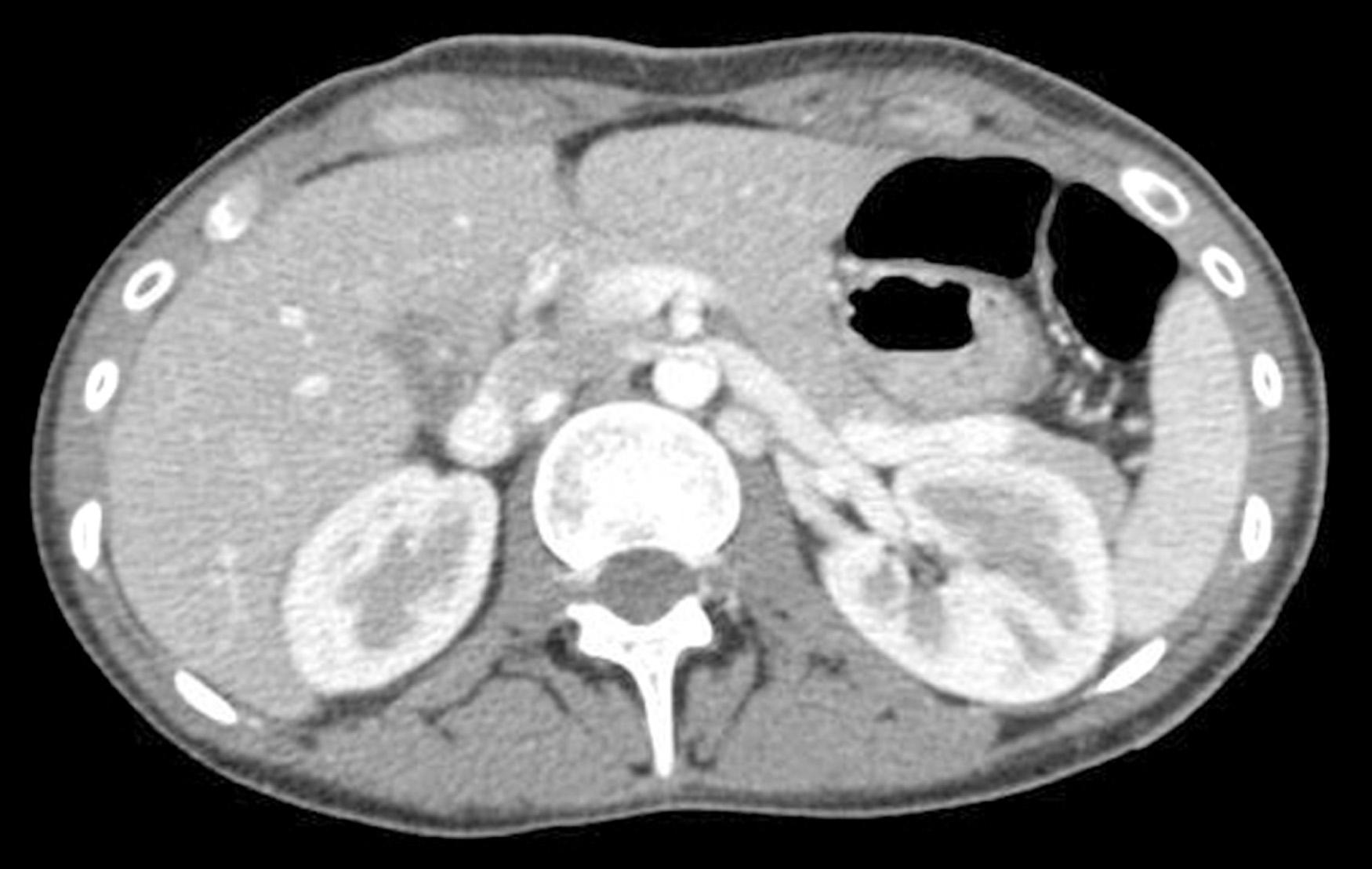
The CIV is formed by the confluence of the external iliac vein, draining the lower extremity, and the internal iliac vein, which provides drainage of the pelvis. Nonthrombotic compression of the CIV most commonly arises from compression of the central left CIV by the overlying right common iliac artery and is often associated with secondary intraluminal band or web formation (May-Thurner syndrome). However, approximately 15% of limbs with primary disease will have involvement of both the common and external iliac veins. It is also now clear that compressive lesions can occur elsewhere, specifically at the crossing of the right common iliac artery over the right CIV, the crossings of the internal iliac arteries, and at the inguinal ligament. However, left-sided lesions are at least 3 times more common than right-sided lesions. Compressive lesions of the CIVs may cause lower extremity symptoms or, in the presence of collateral drainage into a refluxing internal iliac vein, pelvic symptoms.
The internal iliac vein is formed by the confluence of the obturator, branches of the internal pudendal, and gluteal veins, which originate in the thigh, perineum, and buttock respectively. They function as important collaterals for the venous territories drained by the ovarian veins and may also communicate with the lower extremity veins through “escape points” in the pelvic floor. In this manner, the caudal tributaries of the internal iliac veins function much as perforating veins, connecting the deep veins of the pelvis with the superficial veins of the lower extremity. Four escape points from the pelvic veins are commonly identified: the P, I, G, and O points. The perineal or “P” point connects the internal and external pudendal systems and communicates with the veins of the medial thigh and further with the saphenofemoral junction ( Fig. 21.2 ). The inguinal or “I” point connects the ovarian vein, through the round ligament vein and inguinal canal, with the labial veins and saphenofemoral junction ( Fig. 21.3 ). The obturator or “O” point connects the obturator vein with the veins of the medial thigh ( Fig. 21.4 ), and the gluteal or “G” point connects the gluteal veins with the sciatic and posterior thigh veins Fig. 21.5 ). The drainage of the female vulva is particularly complex and includes the internal pudendal, obturator, and round ligament veins from the pelvis as well as the superficial and deep external pudendal veins.
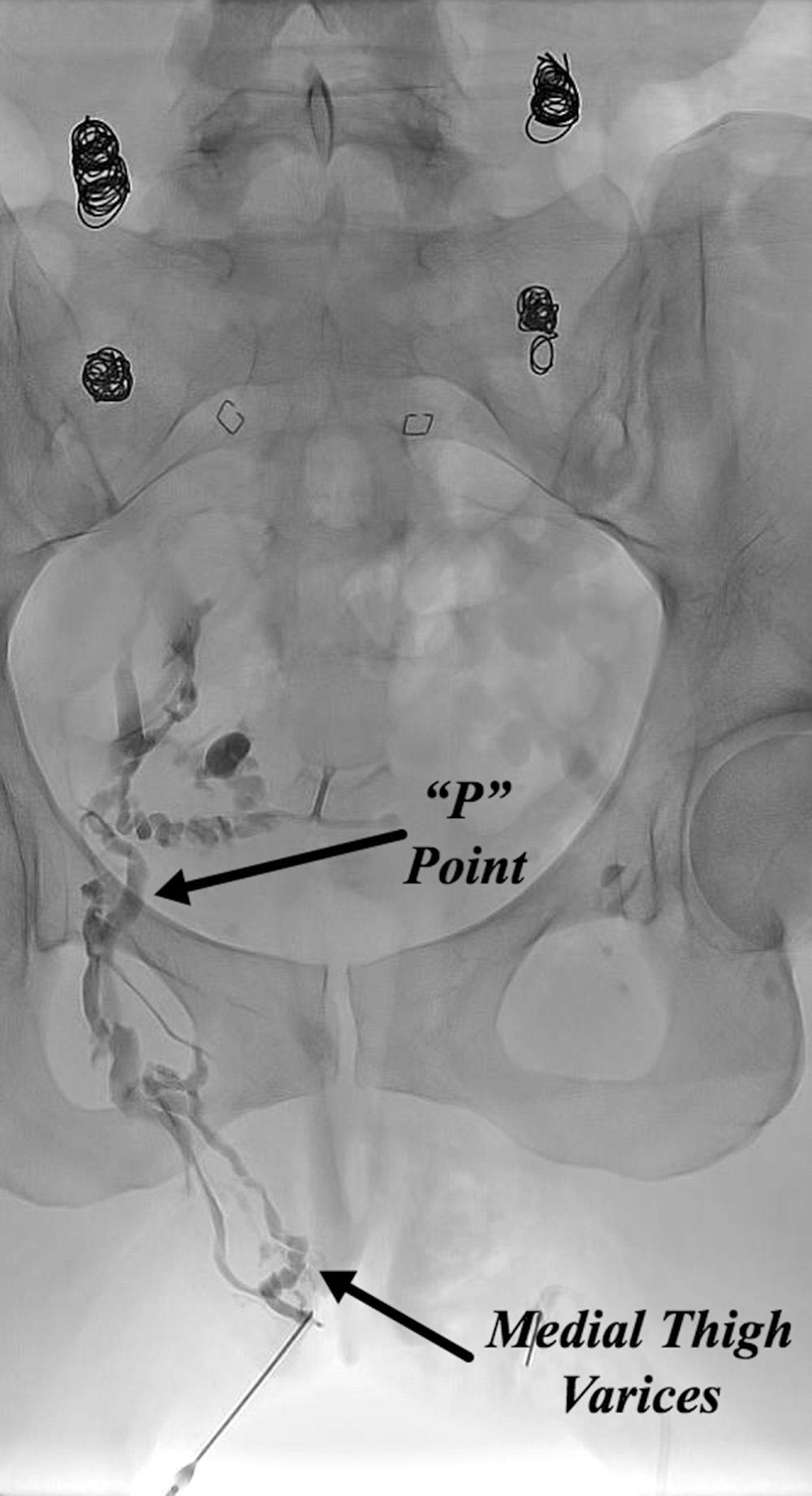
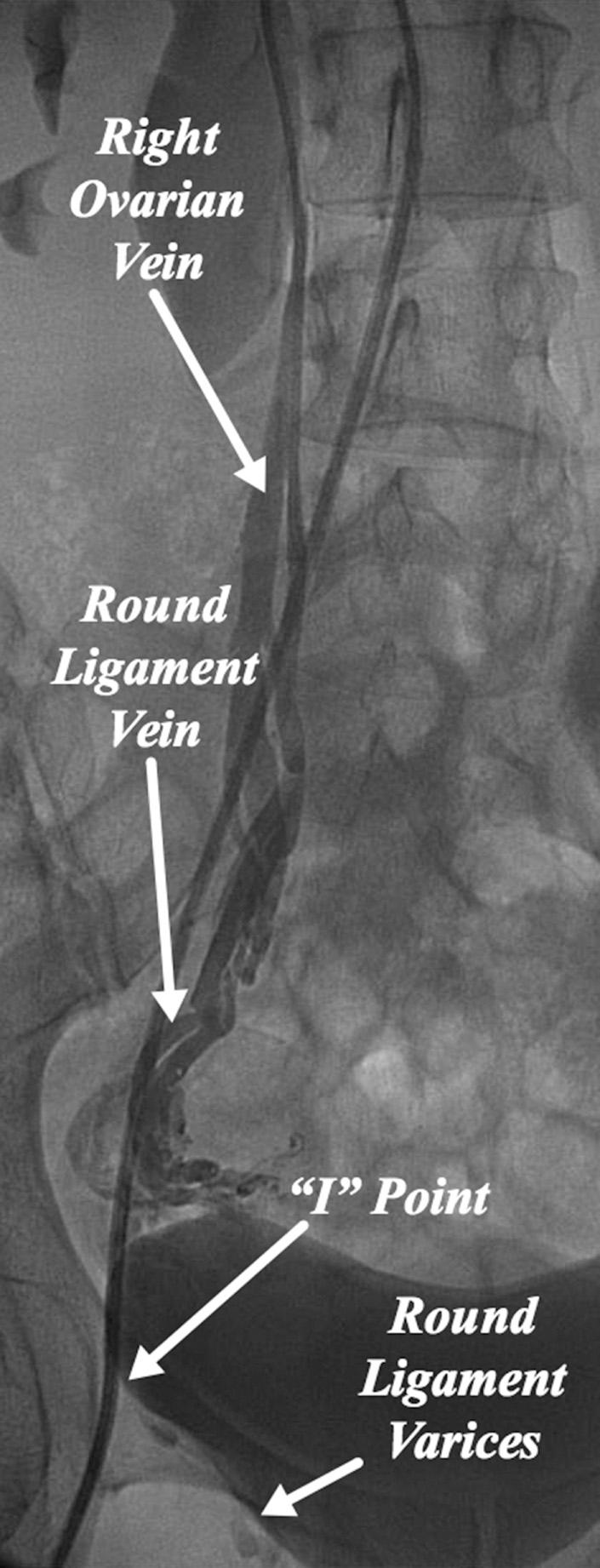
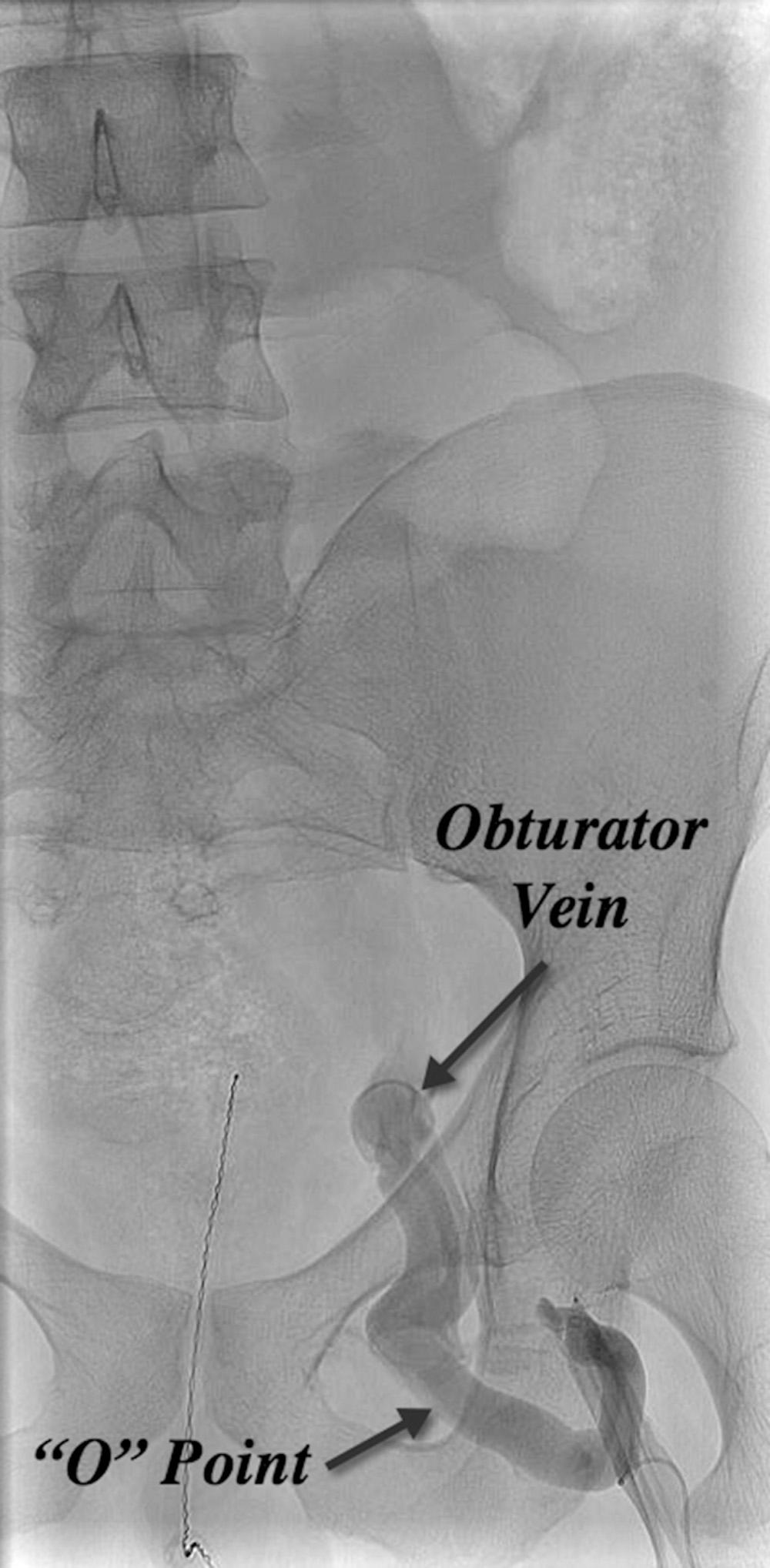
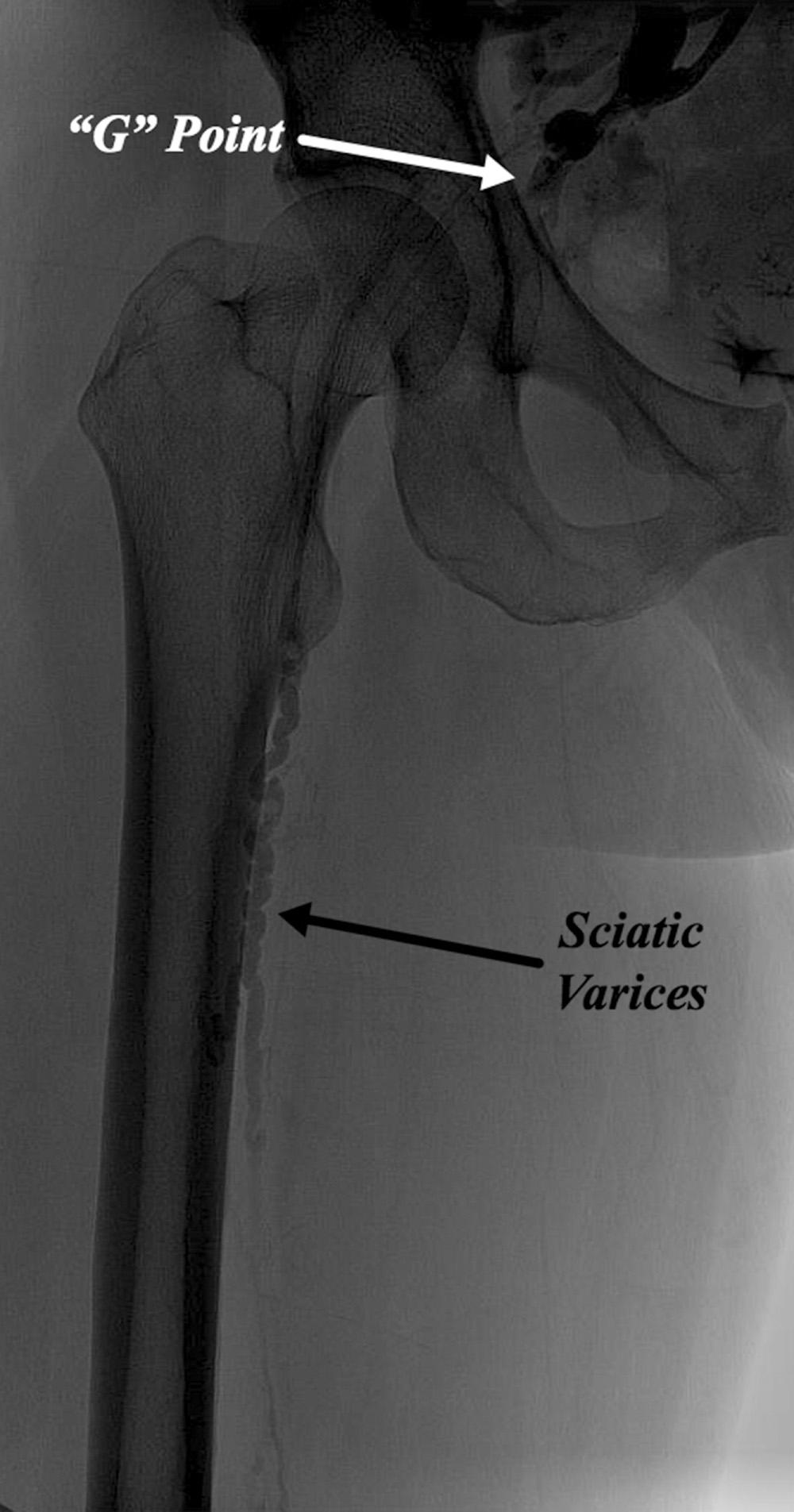
All three venous systems, the renal/ovarian, common/internal iliac, and lower extremity veins can be thought of as terminating in venous “reservoirs” ( Fig. 21.6A–C ). In general terms, venous symptoms can be considered to arise from distention of one of these three venous reservoirs: those of the left renal hilum (NCS), the pelvis (pelvic congestion syndrome), and the lower extremities (pelvic congestion and May-Thurner syndromes). The pelvic venous reservoir, consisting of the plexus of veins associated with the pelvic viscera and broad ligament is central to the clinical manifestations of pelvic venous disorders. Although normally draining via the ovarian veins and tributaries of the internal iliac vein, under pathologic conditions, the plexus may serve as the primary reservoir for drainage of an obstructed left renal vein (NCS); refluxing ovarian or internal iliac veins (pelvic congestion syndrome); or an obstructed left CIV (May-Thurner syndrome). Similarly, the pelvic venous plexus may decompress into the lower extremity reservoir via tributaries of the internal iliac veins. A thorough knowledge of these venous interconnections is critical in understanding the pathophysiology, diagnosis, and management of pelvic venous disorders.
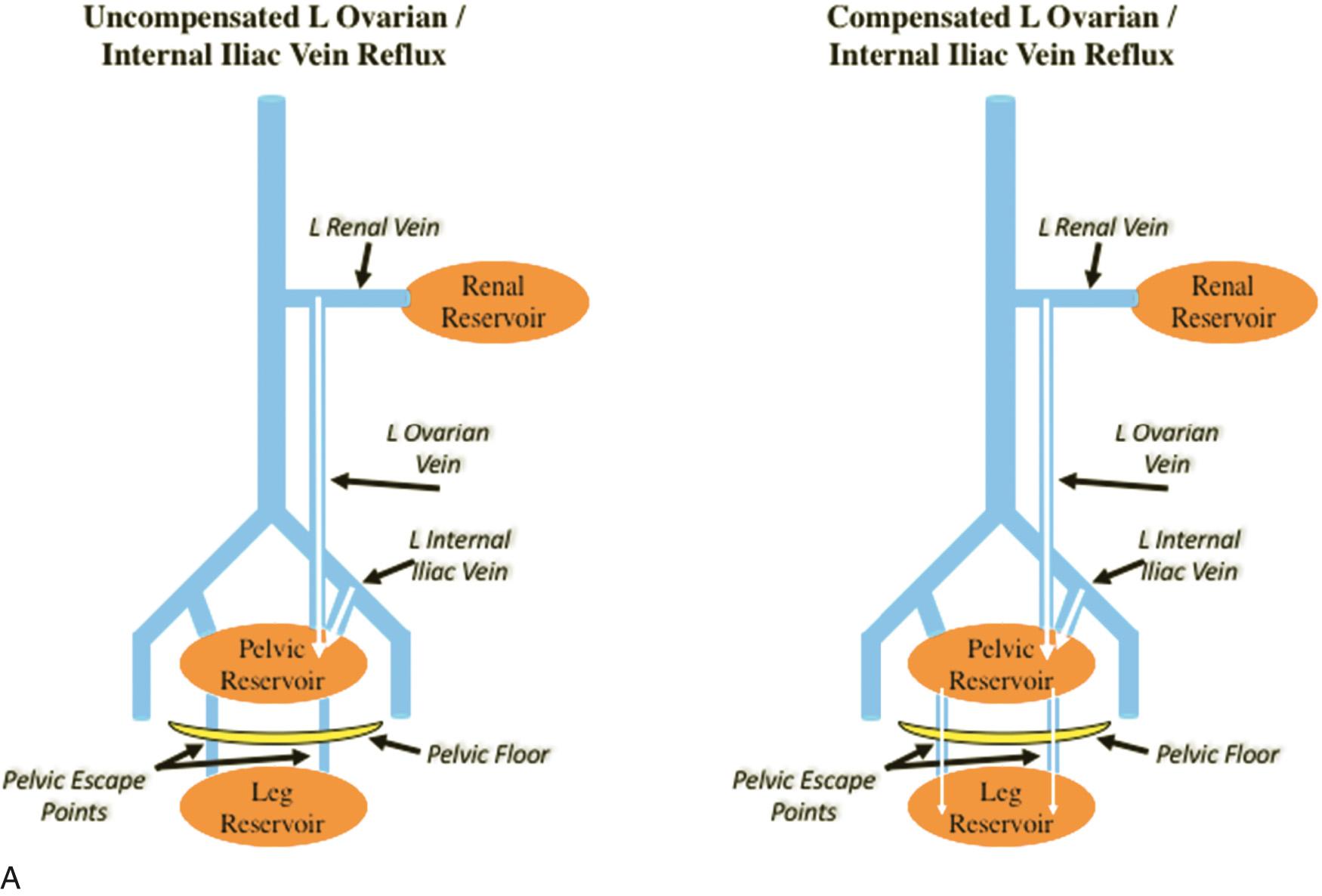
The spectrum of pelvic venous disorders includes four clinical presentations: chronic pelvic pain, pelvic source varices of the leg, symptoms related to renal venous hypertension, and leg swelling. These in turn result from two patterns of reflux; reflux in the ovarian and internal iliac veins, and two patterns of obstruction associated with compression of the left renal and left CIVs. Left renal and common iliac obstruction may in turn cause reflux in the ovarian and internal iliac veins respectively.
Each of the four individual pathologies can be regarded as being either compensated or uncompensated, depending on whether venous pressure is transmitted directly to the distal venous reservoir (renal hilar, pelvic, or leg) or decompressed via collaterals into more caudal veins. For example, uncompensated primary ovarian or internal iliac vein reflux leads to distension of the pelvic venous reservoir and predominant pelvic symptoms in women, whereas decompression via the pelvic escape points in compensated disease leads to typical or atypical lower extremity varices with fewer pressure-related symptoms in the pelvis (see Fig. 21.6A ). In a similar fashion, uncompensated compression of the left renal vein is associated with venous hypertension transmitted to the renal hilar reservoir and symptoms of flank pain and hematuria, whereas collateral drainage via the left gonadal vein in a compensated pattern results in either pelvic symptoms in women or varicocele in men (see Fig. 21.6B ). Finally, elevated upstream venous pressure associated with CIV compression may result in either lower extremity symptoms in uncompensated disease or pelvic symptoms related to decompression via an incompetent internal iliac vein in the compensated state (see Fig. 21.6C ).
Chronic pelvic pain is defined as intermittent or constant pelvic pain persisting for at least 6 months, unassociated with pregnancy, and not occurring exclusively with intercourse or menstruation. Pain is typically noncyclic, that is, background symptoms are often present throughout the month, but typically worsens with menstruation as well as intercourse and prolonged standing. Associated symptoms may include dyspareunia, dysuria, and dysmenorrhea. Postcoital pain is often described as a bursting or aching sensation that may take several hours to resolve. These symptoms are frequently accompanied by depression (25%–50%), anxiety (10%–20%), and somatic complaints (10%–20%).
Pelvic pain of venous origin is presumably related to venous hypertension with dilation and distension of the pelvic venous reservoir, either caused by primary reflux in the ovarian and/or internal iliac veins (uncompensated reflux, Fig. 21.7 ), or secondary reflux because of compression of the left renal or CIVs (compensated obstruction, Fig. 21.8 ). Given the nonspecific and historical nature of the term, pelvic congestion syndrome, it should be replaced by more specific terms, such as chronic pelvic pain, because of primary ovarian or internal iliac venous incompetence, left renal vein compression, or left CIV compression.
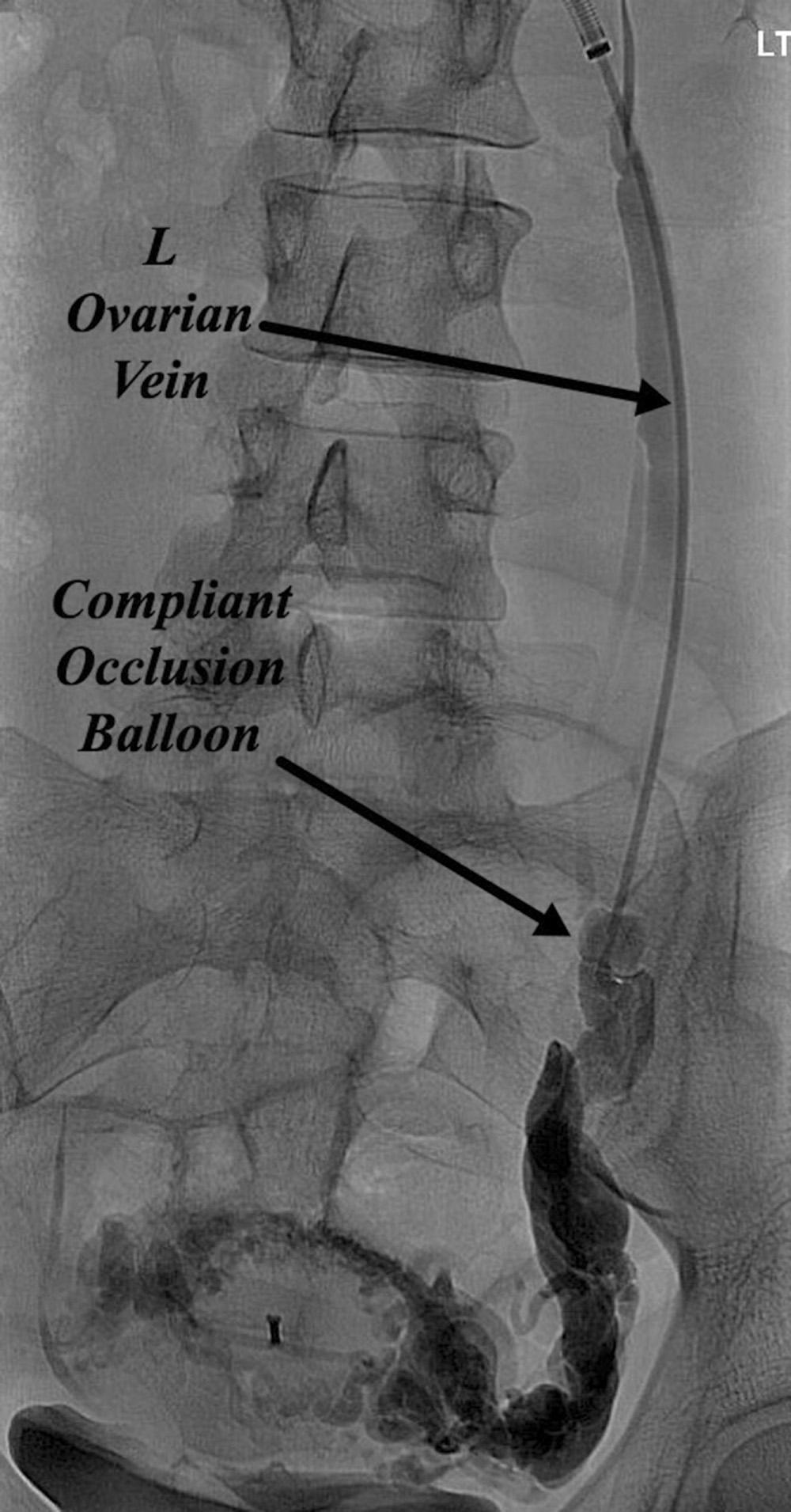
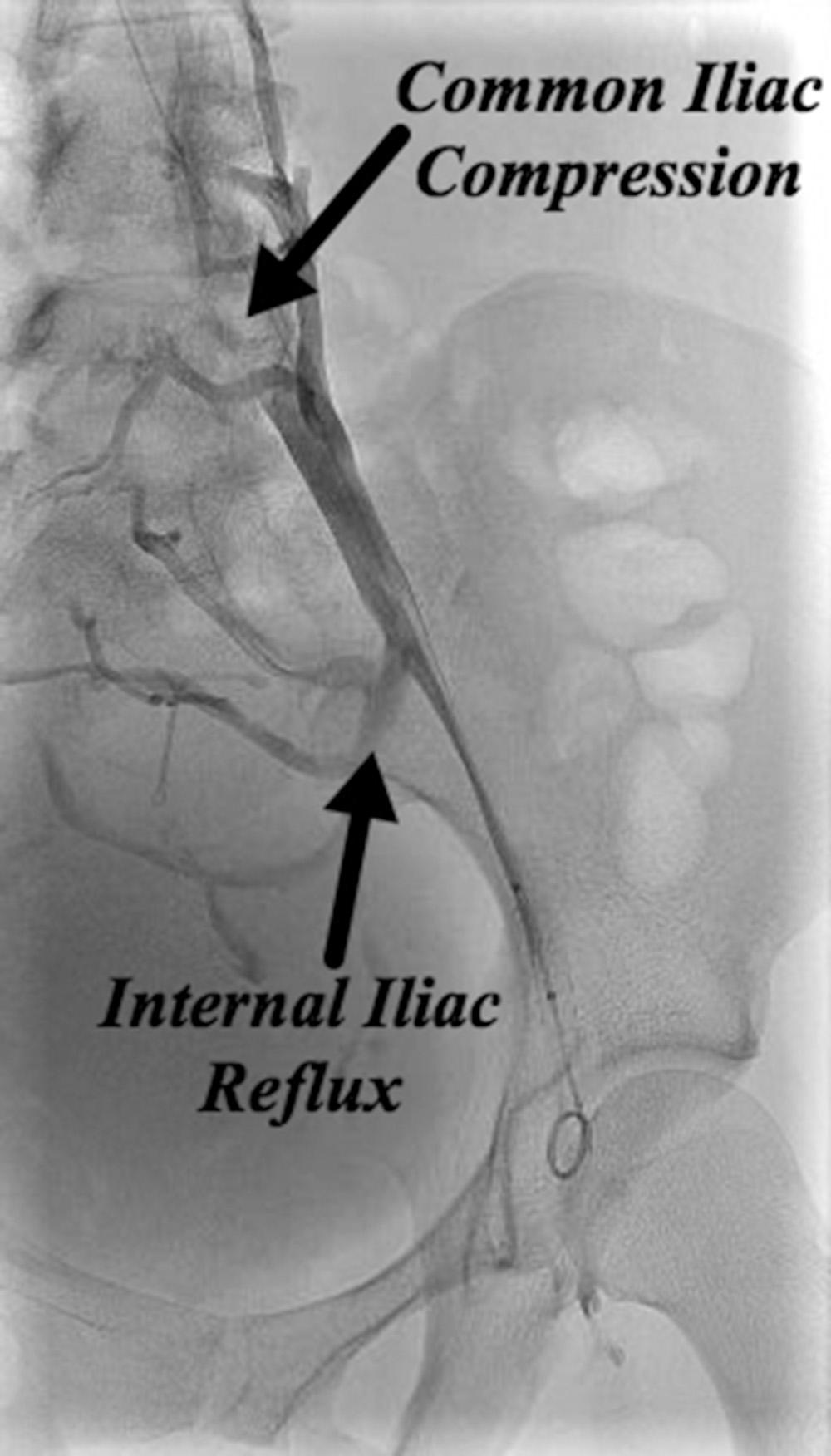
Lower extremity varicose veins, occurring either alone or in combination with chronic pelvic pain, are also a manifestation of pelvic venous disorders. The leg reservoir is the most distal of the three venous reservoirs and pelvic source varices may represent a compensated pattern of primary ovarian or internal iliac venous incompetence or of common iliac or left renal compression. These may develop in atypical locations (vulva, perineum, or buttocks) or, by way of communication with the superficial and deep external pudendal veins, in a great saphenous distribution. Great saphenous varices of pelvic origin may be particularly associated with an incompetent preterminal valve in the presence of a competent terminal valve. An overlooked pelvic origin of lower extremity varices is also a common cause of recurrent varicose veins in women.
Compression of the left renal vein may be associated with either renal (uncompensated pattern) or pelvic (compensated pattern) symptoms. If collateral outflow from the kidney is inadequate, compression of the left renal vein may lead to renal venous hypertension and hilar varices associated with clinical symptoms of left flank pain, orthostatic proteinuria, and hematuria, which may be either gross or microscopic ( Fig. 21.9 ). However, if there is adequate decompression of an obstructed renal vein via collaterals, renal symptoms may be minimal and symptoms related to the more caudal pelvic reservoir may predominate. The gonadal veins are among the most important collateral pathways draining the left renal vein, and differences in anatomy account for the gender differences in the manifestations of compensated disease. In women, the ovarian vein communicates with the pelvic venous plexus, and compensated left renal vein obstruction may be associated with pelvic pain, dysuria and dyspareunia as well as pelvic origin lower extremity varices. In contrast, there is no collateral flow through the pelvis in men, and secondary gonadal vein reflux may lead to a left-sided varicocele ( Fig. 21.10 ). Symptoms are usually more prominent when standing, a finding attributed to visceral proptosis and narrowing of the aortomesenteric angle in the upright position.
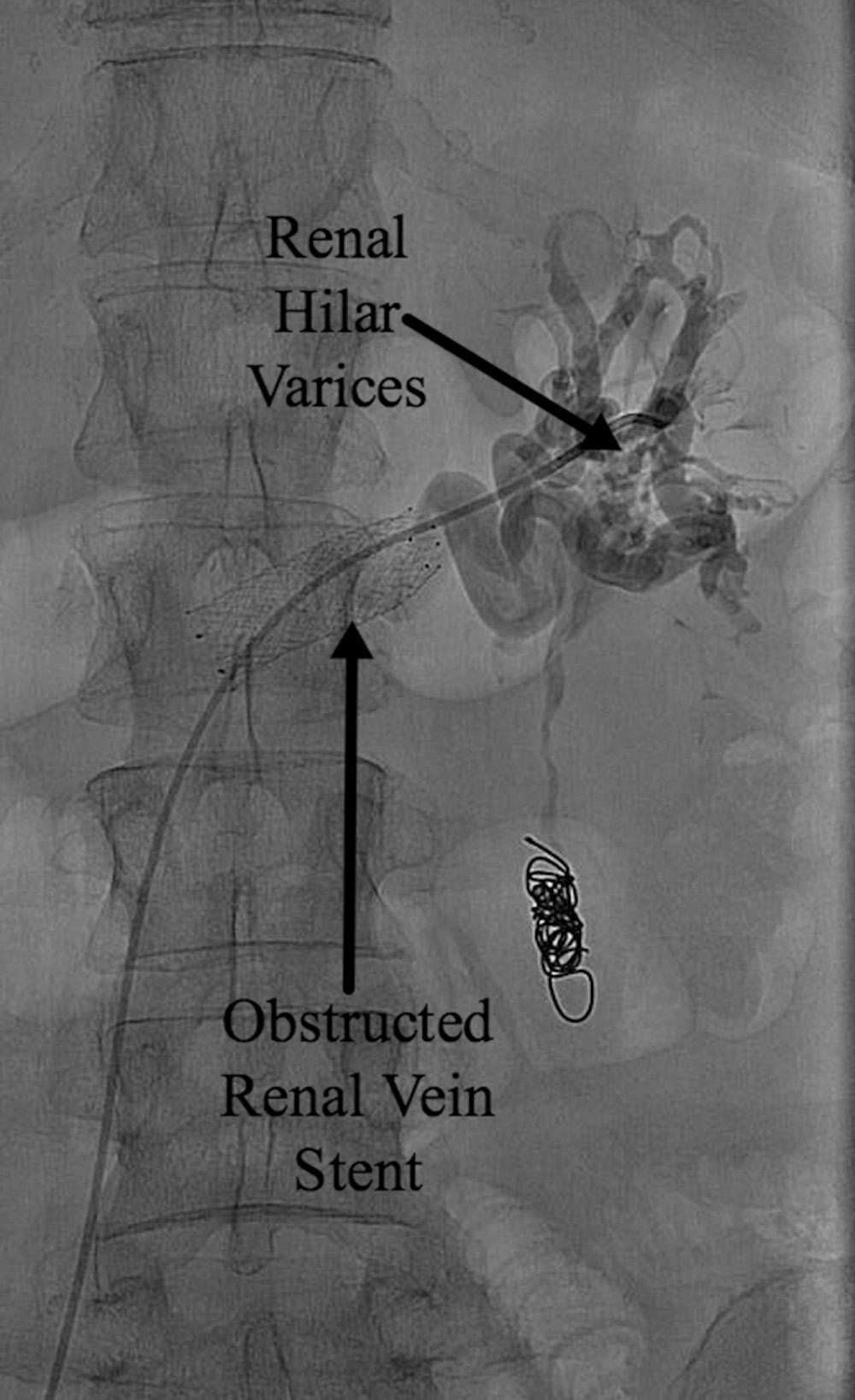
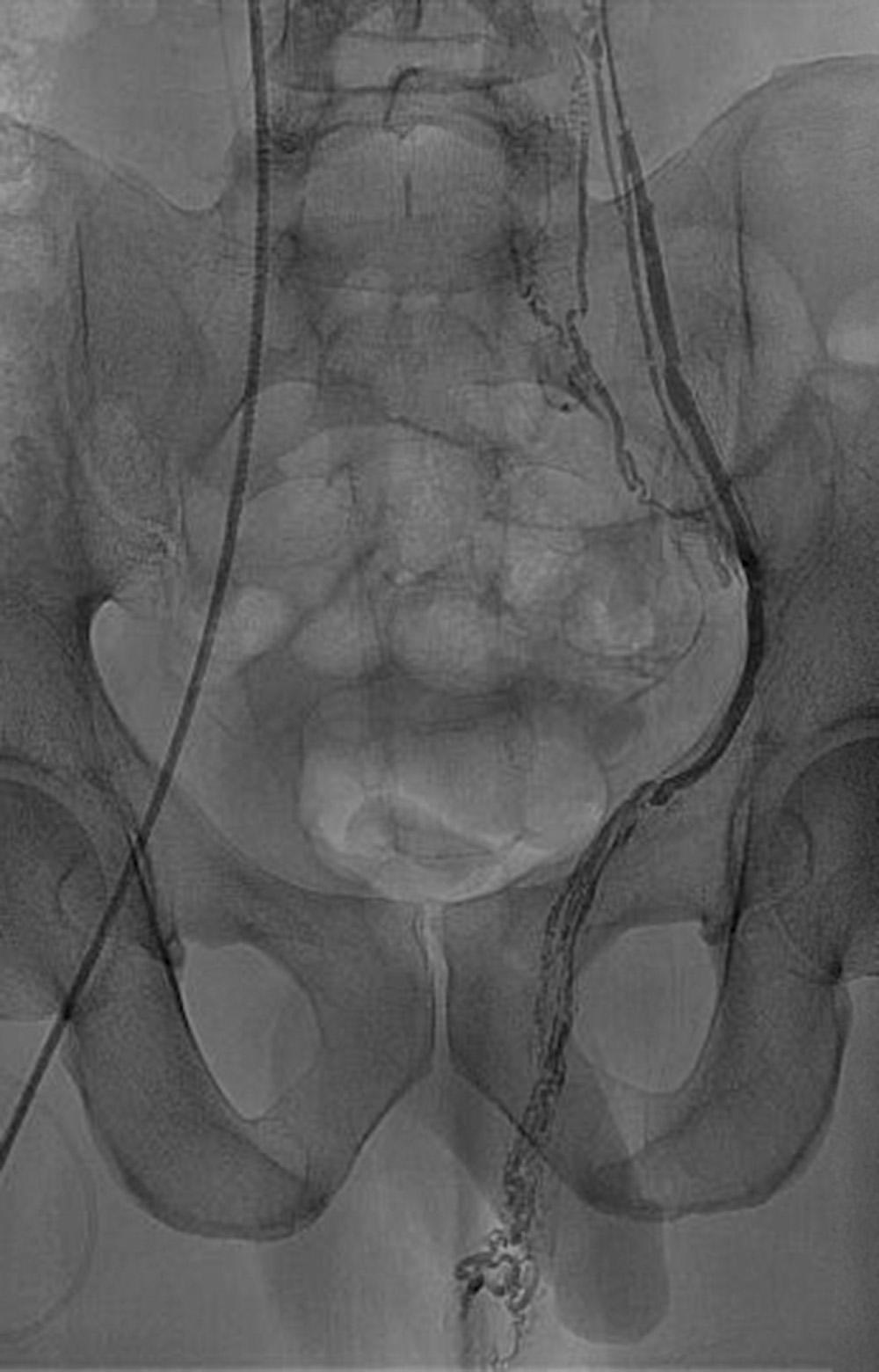
Finally, lower extremity symptoms, including pain spelling and varices, caused by compression of the iliac veins, most commonly on the left side, should be included in the spectrum of pelvic venous disorders. In the event of adequate decompression of increased venous pressure through an incompetent internal iliac vein, primary pelvic symptoms may predominate in women. In contrast, lack of collateralization via the internal iliac vein may lead to primary lower extremity pain and swelling.
As discussed earlier, the clinical manifestations of pelvic venous disease are varied. The precise presentation depends not only on the pattern and distributions of reflux and obstruction, but also on a number of demographic factors including gender, age, parity, and body habitus.
Chronic pelvic pain accounts for approximately 10% of gynecologic visits, with a prevalence estimated to vary from 5.7% in Austria to 26.6% in Egypt. Underlying causes of chronic pelvic pain include endometriosis, pelvic venous disorders, adhesions, uterine leiomyomata, adenomyosis, malignancy, uterine prolapse, and inflammatory bowel disease. Pelvic venous disorders are responsible for approximately one-third of cases and are second only to endometriosis as a cause of chronic pelvic pain. Pelvic symptoms related to underlying pelvic venous disease most commonly occur in premenopausal, multiparous women. Among 57 patients evaluated by Scultetus, the mean age of patients presenting with pelvic venous disorders was 34 years (range 24–48 years) and the mean number of pregnancies was 3.1 (range 2–5). However, note that pelvic varicosities do not uniformly lead to disabling symptoms and asymptomatic varicosities have been reported in 38% to 47% of women patients undergoing cross-sectional computed tomographic (CT) or magnetic resonance (MR) imaging.
Pelvic origin, lower extremity varices may occur either in isolation or in association with typical pelvic symptoms. Vulvar varicosities are reported to account for 4% of women presenting with varicose veins. They complicate 8% and 10% of pregnancies, risk increasing with parity, and usually resolve within 6 weeks of delivery. Approximately one-third of women with pelvic venous disorders have vulvovaginal varices and up to 90% may have lower-limb varices. Conversely, approximately 5% of women presenting with lower extremity varicose veins will have concurrent pelvic symptoms.
Asymptomatic radiographic evidence of left renal vein compression (nutcracker “phenomenon”) is common and must be distinguished from compression associated with clinical symptoms (NCS). The incidence of 50% or more left renal vein compression in patients undergoing routine imaging has varied from 10.9% to 72%. Among patients with CT findings of left renal vein compression, Poyraz found that only 8.8% had hematuria or proteinuria whereas 5.5% had either a varicocele or pelvic congestion. Symptoms have been reported to be more common in asthenic patients, presumably caused by a paucity of retroperitoneal fat, and those with an aortomesenteric angle of less than 16 degrees (normal 35–40 degrees). Symptoms also appear to have a predominance in women and have peak onset in the second or third decade of life. Some have suggested a bimodal age distribution with one peak in adolescents and young adults and a second in middle-aged women. It has been suggested that spontaneous resolution of symptoms may be more common in children and adolescents, presumably caused by either the development of collaterals or changes in anthropomorphic proportions. Spontaneous resolution of hematuria has been reported in up to 75% of adolescents. Left renal vein compression may also present as a varicocele in men, particularly in adolescents, in whom up to one-quarter of patients may have anatomic evidence of left renal vein compression.
As for left renal vein compression, asymptomatic CIV compression is far more common than symptomatic lesions. Nonthrombotic iliac vein lesions are more common in women with a female-to-male ratio of 4 : 1. The original autopsy studies of May and Thurner found spurs at the arterial crossing in 24% of 342 adult cadavers. These spurs were associated with distal thrombosis in one-third of cases. Similarly, Kibbe identified more than 50% compression of the left CIVs in almost one-quarter of patients undergoing CT scanning for abdominal pain, with greater mean compression in females. Marston found the prevalence of such lesions to be higher in patients with advanced venous disease, reaching up to 37% in patients with healed or active venous ulcers. Patients at highest risk for an underlying iliac vein lesion are those with a history of deep venous thrombosis or with axial deep venous reflux.
Become a Clinical Tree membership for Full access and enjoy Unlimited articles
If you are a member. Log in here